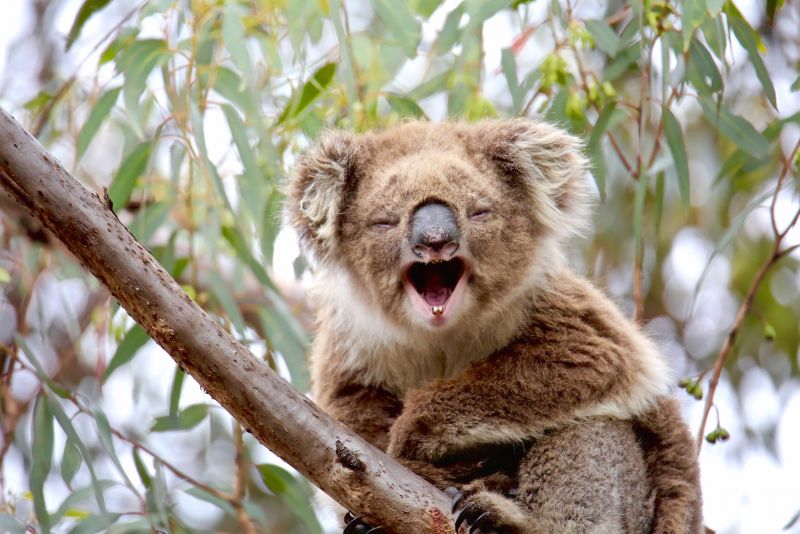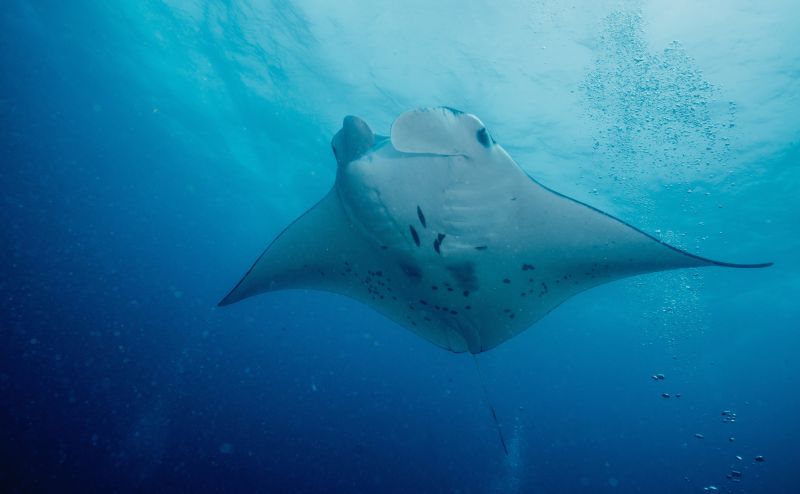As pressures increase from factors such as climate change, extreme weather events, urban or industrial development, plastics pollution and debris, it has never been more important for the tourism sector to unite with academic researchers to measure the impact of these pressures and the health of our ecosystems. Several tourism operators are directly involved in publishing their own research projects or supporting collaborations with academic researchers. Here are four inspiring examples of how tourism contributes to academic research:
1. Discovering the Nose Patterns of Koalas
In 1998, Echidna Walkabout Nature Tours co-founder Janine Duffy discovered a revolutionary method for identifying individual Koalas through their distinctive black and white nose markings. This discovery launched a non-intrusive wild Koala Research Project that continues to this day.
The study, which has documented nose markings over 22 years across more than 100 individual Koalas in four locations in southern Victoria, found that the nose pattern remains essentially the same throughout the Koala's life, with no two patterns being identical. This method provides a cost-effective and non-intrusive way to monitor wild Koala populations, avoiding the need for tagging or handling the animals.

Every wild Koala sighted in the You Yangs or Brisbane Ranges National Parks has been photographed, named, and identified. Their sex, location, tree species, and height in the tree are all noted. The Wild Koala Research Project, fully funded by Echidna Walkabout's social enterprise structure, ensures high success rates with Koala sightings and adds valuable monitoring data to each day's observations.
This isn't Echidna Walkabout's only contribution to academic research. In 2015, Echidna Walkabout and the Koala Clancy Foundation reported the observation of koalas drinking stemflow, which is water running down the trunk or branches of a tree. Prior to this, it was widely believed that koalas didn't drink and obtained all the water they needed from the leaves they ate. In a paper written on this subject by Dr. Valentina Mella (2020) from the University of Sydney, 44 of the 46 observations referenced were reported by Echidna Walkabout, with their contribution well recognised. Read more here.
Related Tour - East Gippsland Wildlife Journey (4D/3N)
Venturing across East Gippsland's magnificent lush rainforests, coastal heathlands, giant eucalypt groves, white sandy beaches and pristine rivers and estuaries, this four day immersive adventure offers you encounters with an incredible array of species.
- It is especially attractive to enthusiasts looking to spot some of the more shy forest dwellers including Yellow-bellied and Sugar Gliders, Swamp Wallabies, King Parrots and the piercing call of the Eastern Whipbird.
- Other highlights include walking with Eastern Grey Kangaroos and Echidnas on Raymond Island, searching for koalas in eucalypt forests, spotting Lace Monitors lazing beside secluded rivers and listening for Superb Lyrebirds mimicking other birds on the fertile rainforest floor.
- You will also spend a little time helping nature, by setting up a wild koala research project on an island refuge, conducting bushfire-recovery wildlife surveys and removing disused fishing nets. Charming lodge-style, owner-operated boutique accommodation ensures a comfortable sleep across the journey.
2. Creating the Largest Humpback Database in Australia
Pacific Whale Foundation's research in Australia began in Hervey Bay in 1984 when founder Greg Kaufman visited South East Queensland as part of a documentary film project. Recognising the area as a critical resting place for Humpback Whale mothers and calves, Greg and his team embarked on a long-term study of these majestic mammals.
Each whale has unique features, such as the shape of their flukes, trailing edges, acquired scars, and natural pigmentation. These characteristics allow researchers to identify and track individual whales. Pacific Whale Foundation scientists have established the longest-running Humpback Whale photo-identification project in the South Pacific. Their Southern Hemisphere Humpback Whale Catalogue is the largest curated database of photo-identified Humpback Whales in East Australia, documenting detailed life histories of over 6,900 whales that visit Hervey Bay from July to October.

Hervey Bay is unique as a mid-migratory resting ground for Humpback Whales, particularly for mother and calf pairs. Research focuses on long-term monitoring and quantifying potential threats to these whales. The team also studies Humpback Whale movement and connectivity among various areas of eastern Australia and between the Pacific and Indian Oceans. Their extensive library of peer-reviewed journal articles, technical reports, conference presentations, and supported research underscores their significant contributions to scientific understanding of Humpback Whale ecology and behavior.
You can view Pacific Whale Foundation's list of publications and references that have utilised 40 years of data collection here.
Related Tour - Ultimate Hervey Bay Whale Watching (3 Hours)
Explore the world's first declared Whale Heritage Site at Hervey Bay, known for coming alive with thousands of Humpback Whales between July and October. This region is known for having some of the most active and inquisitive whales found anywhere across the globe, with breaches, whale songs and muggings common practice.
- Part of the Great Sandy Marine Park, the region also provides you with the opportunity to see turtles, dolphins, dugongs and other marine life, along with an amazing amount of different sea birds.
- Being the only Hervey Bay tour operator to have conducted over 35 years of local Humpback Whale research, you will learn firsthand about historical and latest whale findings from marine biologists, as they collect data for ongoing research studies.
- You will have the opportunity to use underwater hydrophones to listen to live whale songs!
- All proceeds from sales of the whale watching experiences support whale and dolphin research, marine education for children, and ocean conservation programs in Australia and around the world.
3. Revealing the Mysteries of Bremer Canyon & Beyond
Orcas were first 'discovered' off Bremer Bay in the early 2000s by Dave Riggs during an annual tuna research expedition from Esperance to Albany. In 2013, he produced a film called The Search for the Ocean's Super Predator, which spurred further interest. Not too long after, Naturaliste Charters, led by owner Paul Cross, collaborated with Dave to run the first dedicated expedition to see Orcas in Australian waters.

Naturaliste Charters has become a national leader in supporting research projects, regularly hosting active researchers and partnering with institutions and organisations to publish papers.

Their contributions have led to a comprehensive list of articles, ranging from the effect of El Niño Southern Oscillations on apex predators to tracking rare pelagic bird species for the BirdLife Australia Rarities Committee. They have also documented incredible Orca predation events off Bremer Bay, including those involving Blue Whales.
|
Species of Focus |
Research Groups & Academics Supported |
|
Killer Whales |
West Australian research group Project O.R.C.A. and Murdoch University |
|
Cetaceans including Humpback, Blue, Southern Right, and Minke Whale |
Southwest Whale Ecology Study (SouWEST) integrating the research expertise of Western Whale Research (Dr. Chris Burton), Oceans Blueprint (Dr. Chandra Salgado- Kent) and The Centre for Marine Science and Technology at Curtin University and Geographe Marine Research |
|
Baleen Whales |
Geographe Marine Research (GMR) |
|
False Killer Whales |
International scientist Jochen Zaeschmar |
|
Sunfish |
International scientist Marianne Nyegaard |
|
Pelagic Seabirds |
Birdlife Australia Rarities Committee (BARC) and eBird including surveys with Daniel Mantle and Plaxy Barratt |
Related Tour - Bremer Canyon Killer Whale Expedition (Full Day)
The Bremer Canyon has become one of the most sought-after whale watching expeditions across the globe, with over 100 Killer Whales (Orcas) returning to the submarine canyon each year from December to April; the only place in Australia where you can regularly encounter Killer Whales in the wild.
- During the season, travellers can encounter these apex predators engaging in a variety of activities from hunting to socialising in family groups.
- As well as encountering Killer Whales over 95% of the time, other species seen include Bottlenose, Striped and Common Dolphins, Long-Finned Pilot Whales, Sperm Whales, Hammerhead, Oceanic Blue and Whaler Sharks, Australian Sea Lions, New Zealand Fur Seals, Giant Squid, Oceanic Sunfish and even the rare Beaked Whale.
- It's also a pelagic birdwatchers dream, with an astonishing array of seabirds including the Wandering Albatross, Indian Yellow-nosed Albatross, Flesh-footed Shearwater and petrel species.
- Every expedition by Naturaliste Charters is led by a qualified marine biologist with extensive knowledge and experience in local marine ecology, wildlife and environmental education.
4. Understanding Manta Rays with Project Manta
Manta Rays have been around for millions of years, and their reliable aggregations are an important part of Western Australia's marine ecotourism offering. Yet, it was only discovered as recently as 2009 that there are two species of Manta Rays, highlighting how much we still have to learn about our oceans. Almost all of the information available about reef Manta Rays globally has come from the last ten years, emphasising the importance of ongoing research to expand our knowledge of their population ecology and biology within Australian waters.

Project Manta was founded in 2009 at Brisbane's University of Queensland. In 2015, the multidisciplinary organisation joined forces with researchers at Murdoch University in Perth, expanding Manta Ray studies from the east coast to the west of Australia. The work being done on Ningaloo is progressing well, focusing on the movement, biology, diet, and migratory patterns of Manta Rays. Exmouth Dive & Whalesharks Ningaloo has been crucial in supporting these studies and sharing findings with their guests.

Researchers often join charter boats with Exmouth Dive & Whalesharks Ningaloo to discuss Manta Rays with interested guests. The two hotspots in Western Australia for monitoring Manta Ray activity are Exmouth and Coral Bay. Thanks to the unique spot patterns on the belly of reef Manta Rays, combined with ongoing photo ID submissions from the public, Project Manta has identified more than 1200 individuals that call Ningaloo home.
Related Tour - Outer Reef or Islands Scuba Dive & Snorkel (Full Day)
Discover the wonders of the Muiron Islands and Ningaloo Marine Park, regarded as one of the most beautiful underwater wilderness areas in Australia.
- Upon cruising out across the pristine waters, you will spend the day exploring different snorkel and dive sights accessible by boat only, with Dolphins, Rays and Turtles all regular encounters.
- Snorkellers will be delighted to see colourful tropical fish including Parrotfish, Butterflyfish, Angelfish and Anemonefish amongst the spectacular coral bombies.
- Three species of turtle, Olive Sea Snakes, Manta Rays, Reef Sharks and surreal Nudibranches are highlights for enthusiasts. Free Nitrox for is available on all dives free of charge, with PADI Courses & Discover Scuba available for any unqualified visitors.
Tourism's involvement in academic research not only enhances visitor experiences but also provides crucial data and insights that drive conservation efforts and deepen our understanding of the natural world. These collaborations between tourism operators and researchers highlight the powerful synergy that can exist between tourism and science.

